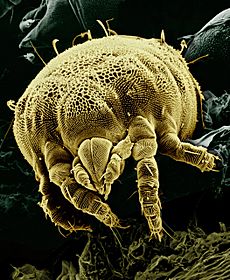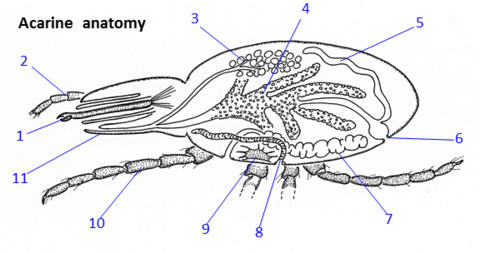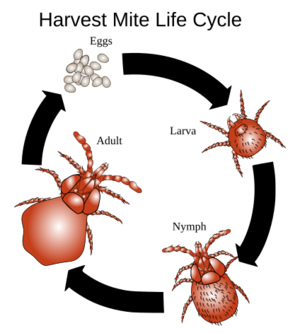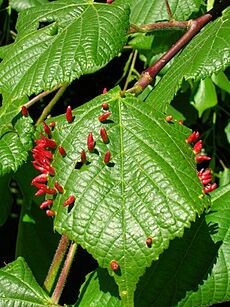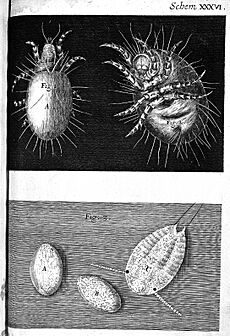Acarina facts for kids
Quick facts for kids Mites
|
|
|---|---|
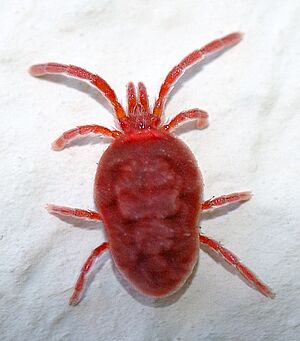 |
|
| Trombidium holosericeum mite (Acariformes) | |
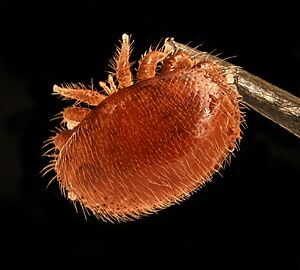 |
|
| Varroa destructor (Parasitiformes) | |
| Scientific classification | |
| Kingdom: | Animalia |
| Phylum: | Arthropoda |
| Subphylum: | Chelicerata |
| Class: | Arachnida |
| Mites are found in two superorders | |
Mites are tiny arachnids, which means they are related to spiders and have eight legs. They belong to two main groups called Acariformes and Parasitiformes. Most mites are very small, usually less than 1 millimeter (about 0.04 inches) long. Their bodies are simple and not divided into many segments.
Because of their small size, mites are often hard to spot. Some live in water, while many others live in soil, helping to break down dead plants and animals. Some mites live on plants, sometimes causing bumps called galls. Other mites are predators, hunting smaller creatures, or parasites, living on or in other animals. For example, Varroa mites are harmful parasites of honey bees, and some mites cause an itchy skin condition in humans. Most mites are harmless to people, but a few can cause allergies or spread illnesses.
The scientific study of mites is called acarology.
Contents
What Are Mites?
Mites are not a single scientific group, but a common name for two different groups of arachnids: the Acariformes and the Parasitiformes. Scientists are still learning about how these groups are related to each other and to other arachnids. They use special tools, like studying the DNA of mites, to understand their family tree.
Mites Through Time: Their Fossils
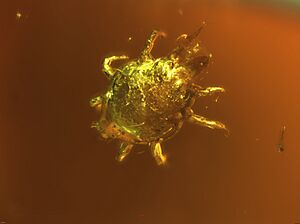
Finding mite fossils is rare because they are so small and delicate. The oldest known fossils of acariform mites are about 410 million years old. They were found in Scotland. The earliest fossils of parasitiform mites are younger, about 100 million years old, and were found in amber. Most mite fossils found are from the last 65 million years.
How Mites Are Built
Outside Appearance
Mites are tiny members of the Arachnid family. Most are between 0.25 to 0.75 millimeters (0.01 to 0.03 inches) long, but some can be as small as 0.1 millimeters (0.004 inches). Their body has two main parts: the cephalothorax (front part, like a head and chest combined) and the opisthosoma (back part, like an abdomen). These parts are usually fused together, so the body looks like one simple shape.
At the very front is a special feeding part called the gnathosoma. This isn't a true head because it doesn't hold the eyes or brain. It has mouthparts like chelicerae (pincers or blades) and pedipalps (small feelers). These parts help the mite grab and eat its food. The gnathosoma can often be pulled back into the body.
Most mites have four pairs of legs, making eight legs in total. Some, like gall mites, have only two pairs. Each leg has six segments and can be changed for different uses, like swimming. The top and bottom of a mite's body are covered in hard plates. The opening for reproduction is on the underside, between the fourth pair of legs. Some mites have one to five eyes, but many are blind. They often have special bristles called setae on their bodies and legs, which can help them sense their surroundings. Mites come in many colors, like brown, red, orange, black, or green.
Many mites breathe through small openings called stigmata. These openings are sometimes connected to tubes called peritremes, which are part of their breathing system. The location and type of these breathing structures help scientists classify different groups of mites. For example, some mites breathe through their skin, while others have stigmata at the front or middle of their bodies.
Inside a Mite's Body
Mites have salivary glands that help them digest food. Most mites have two to six pairs of these glands. Some mites don't have an anus and never release waste during their short lives. Most mites don't have a heart; instead, their body muscles help move fluids around inside them. However, larger mites and ticks do have a heart. Mites breathe through their body surface, and many also have special air tubes called tracheae. They also have Malpighian tubules, which are like kidneys, to help remove waste.
Several types of mites can produce silk from special glands. They use this silk for different reasons, such as building shelters or helping them move. Water mites also make long, thin threads that might be silk.
Mite Life Cycle and Reproduction
Mites have separate sexes, meaning there are male and female mites. Males have testicles and females have an ovary. In most mites, the male transfers sperm to the female indirectly. He might leave a packet of sperm on a surface for the female to pick up, or use his mouthparts or legs to place it inside her. Some male mites have a special organ for direct transfer.
Female mites lay their eggs in their habitat. The eggs can take up to six weeks to hatch. After hatching, mites go through several stages of growth, called instars, before becoming adults. These stages can look different, and some mite groups skip certain stages. All mites eventually reach an adult stage. Mites generally have shorter lifespans compared to many other arachnids.
Where Mites Live and What They Do
Mites in Nature's Web
Mites live in many different places and play various roles in nature. For example, Oribatida mites are important decomposers in many environments. They eat dead plants, fungi, and other decaying materials, helping to recycle nutrients. Some mites are predators, while others are parasitic.
Mites are one of the most diverse and successful groups of invertebrates. They live almost everywhere: in fresh and saltwater, in soil, forests, fields, farms, and even in hot springs and caves. They are very common in leaf litter and feed on animals, plants, and fungi. Scientists have described about 48,200 species of mites, but there could be over a million more waiting to be discovered!
Some mites have amazing abilities. The tropical mite Archegozetes longisetosus is one of the strongest animals in the world for its size. It can lift over 1,182 times its own weight! Another mite, Paratarsotomus macropalpis, holds the record for the fastest animal on Earth relative to its length.
Mites living in soil are very important. Different types of mites, like Oribatida and Prostigmata, are more common in soil than others. If soil is disturbed, most mites can return within a few months, but Oribatida mites might take several years to fully recover.
Mites That Live on Others
Many mites are parasitic, meaning they live on or in other plants and animals and get their food from them. For example, some mites live in the nests of birds and other animals, feeding on blood or skin. Dust mites, which feed on dead skin and hair shed by humans, are related to these nest mites. Ticks are a well-known group of mites that are parasites of animals like mammals and birds, feeding on their blood.
Mites can also be parasites of insects. Varroa destructor mites attach to honey bees, and Acarapis woodi mites live inside their breathing tubes. Hundreds of other mite species are found with bees, some as parasites and others as helpful partners. Mites also parasitise some ant species. Many young mites (larvae) are external parasites of other arthropods, while older mites in the same group often become predators.
Plant pests include spider mites, thread-footed mites, and gall mites. Some mites that affect animals include sarcoptic mange mites, which can cause an itchy skin condition by burrowing under the skin. Demodex mites are parasites that live in or near the hair follicles of mammals, including humans.
How Mites Travel Around
Since mites cannot fly, they have other ways to move from place to place. For short distances, they simply walk. Some species climb to a high spot, spread out, and let the wind carry them away. Others release a silk thread and "balloon" to new locations on the wind.
Parasitic mites often travel with their hosts. They spread from one host to another through direct contact. Another way mites travel is called phoresy. In this method, a mite, often with special claws or suckers, latches onto an insect or another animal. It then gets a free ride to a new place. A phoretic mite is just a hitchhiker and doesn't feed while being carried. These traveling mites are usually species that reproduce quickly and can settle into new homes fast.
Mites and People
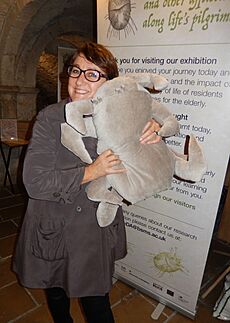
Mites are tiny, and apart from those that affect humans or our economy, they are not widely studied. Most mites are helpful. They live in soil or water and assist in breaking down dead organic material, which is important for the carbon cycle.
Two species of mites, Demodex folliculorum and Demodex brevis, live on humans. They are often called eyelash mites.
Mites and Your Health
Most mite species do not harm humans or domestic animals. However, a few species can live on mammals and cause or contribute to allergies. They can also carry germs that spread illnesses. Mites that live on human skin can cause several types of itchy skin rashes, such as scabies. Sarcoptes scabiei is a parasitic mite responsible for scabies, which is a common skin condition in children. Demodex mites, which cause mange in dogs and other animals, have also been linked to a human skin condition called rosacea.
Ticks are well known for carrying diseases, such as Lyme disease and Rocky Mountain spotted fever.
Chiggers are known for their itchy bite. They can also spread certain illnesses in some situations. House dust mites, found in warm and humid places like beds, cause several types of allergic diseases, including hay fever, asthma, and eczema. They are also known to make atopic dermatitis worse.
Among domestic animals, sheep can be affected by the mite Psoroptes ovis, which lives on their skin and causes irritation.
Mites and Honey Bees
The mite Varroa destructor is a serious problem for honey bees. It contributes to the decline of bee colonies in commercial hives. This mite is a parasite that can only reproduce in bee colonies. It weakens bees by feeding on their fat and can spread RNA viruses, including deformed wing virus. A heavy infestation can cause a bee colony to die, especially during winter. Since 2006, over 10 million beehives have been lost due to various factors, including these mites.
Mites Helping Farmers
Various mites hunt and eat other small invertebrates. Because of this, they can be used to help control pest populations. For example, mites from the family Phytoseiidae, especially species like Amblyseius, Metaseiulus, and Phytoseiulus, are used to control pests like spider mites. Among the Laelapidae family, Gaeolaelaps aculeifer and Stratiolaelaps scimitus are used to control fungus gnats, poultry red mites, and other soil pests.
Mites in Stories and Science
Mites were first seen under a microscope by the English scientist Robert Hooke. In his 1665 book Micrographia, he described them as "very prettily shap'd Insects," showing they were not just dirt. In 1898, Arthur Conan Doyle wrote a funny poem called "A Parable" about cheese mites arguing about where their round cheddar cheese home came from. The world's first science documentary, shown in London in 1903, featured cheese mites seen through a microscope. This film made simple microscopes very popular!
Related pages
See also
 In Spanish: Acari para Niños para niños
In Spanish: Acari para Niños para niños
- Copra itch
- Gamasoidosis
- Grain itch
- Grocer's itch


